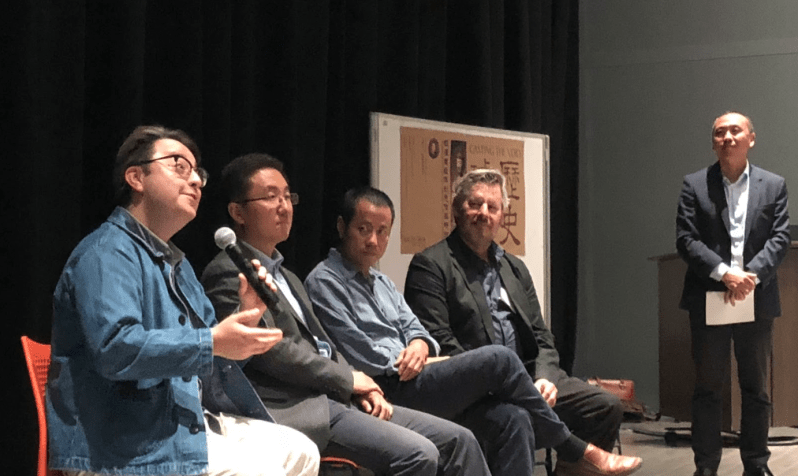On June 21, art professor Xiaoze Xie spoke about artistic creation and presented his unfinished artwork inspired by a 25-day expedition to the historic Silk Road trade town of Dunhuang in China. Xie’s talk, entitled “Casting the Void: Reinvention of the Library Cave in Dunhuang,” took place in McMurtry’s Oshman Hall.
According to Richard Vinograd, a professor of Asian art who spoke at the event, Dunhuang is a former crossroads of material goods, cultures and religions that contains the Mogao Caves, a UNESCO World Heritage Site featuring collections of murals, banners and manuscripts virtually untouched since the eleventh century. Uncovered in the past century, these troves of ancient works have offered insight into Buddhist influences on the communities of Central Asia. They also have become objects of fascination and study by historians around the world.
Xie visited the site in the summer of 2017 as an artist in residency for the Dunhuang Foundation. While there, he studied Cave 17, which contained large amounts of Buddhist artworks and writings dating back to the ninth century Tang dynasty.
“Since the 1940s, Dunhuang has been a holy site for artistic pilgrimage,” Xie said.
Xie reflected on his works and on the common attributes they exhibit. He spoke of his personal obsession with “time, memory and human documentation of history.”
Xie’s initial idea was to make a lifesize cast of Cave 17, inside which he would include elements such as text, images and diagrams inspired by Buddhist ideas. Applying his interests in calligraphy and conceptual art installations, Xie wanted to imbue his work with spiritual, transcendental elements.
One of his finished works featured a mountain, which according to Xie separated the physical and spiritual universes from each other. The work also included calligraphic labels for elements ranging from a fortress to fluid lines of wind, water, gold and hail. However, Xie explained that nirvana, one of the most important concepts of Buddhist enlightenment, couldn’t be depicted in his rendition of Buddhist cosmology, as Buddhists believe the phenomenon is beyond diagramming.
“In this two dimension drawing, I tried to understand the structure of [Buddhist] cosmology,” Xie said. “When looking at one unit, in Buddhist theory, it multiplies by thousands.”
Another piece in the collection reimagines the drawing on a 3-dimensional plane with bodhisattvas floating at the top. Xie created casts for the bodhisattva models based off of his sketches, and is looking to do the same for other sculptures and installations present in the caves as well.
“[Xie’s exhibition] is definitely one of the most meaningful art events that I’ve attended,” said audience member environment and resources Ph.D. student Jennifer Wang. “[It has] not only encouraged me to discover the beauty of Dunhuang with my own eyes, but also has made me want to become a volunteer for similar projects.”
During the event, Vinograd also elaborated on controversies behind Western explorers like Aurel Stein and Paul Pelliot who relocated many artifacts from the Mogao Caves to Europe in the early twentieth century.
“[Stein] was the acquirer of a large case of material from the custodian, which now resides in the British Museum […] for better or for worse,” Vinograd said.
According to Vinograd, these European explorers were criticized for displacing another country’s cultural artifacts. However, they also sparked international interest and stimulated scholarship in Dunhuang.
Dunhuang Foundation executive director Christian Hudak and Tsinghua University journalism and communication professor Yu Hu also joined the fireside chat to discuss the increasing importance of projects like Xie’s to facilitating understanding between American audiences and Chinese culture.
Xie said that he looks forward to going back to Dunhuang if given the opportunity, likening the caves to an “ember of history” preserving Chinese culture.
The event was co-sponsored by C-Lab Foundation, a nonprofit established by The Committee of Culture Creativity of Tsinghua Alumni Association, The Dunhuang Foundation and the Department of Art and Art History at Stanford University.
Xie’s newest exhibition, “Eyes On: Xiaoze Xie,” is currently on display at the Denver Art Museum until Jul. 8.
Contact Jessica Zhang at jessica ‘at’ stanforddaily.com.
